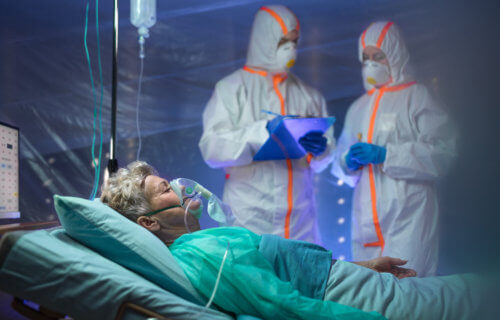LONDON — The COVID pandemic has increased the willingness of doctors to not resuscitate the very sick and frail, a new study says.
Study author Dr. Benjamin Kah Wai Chang of St Mary’s University and researchers found that the pandemic has changed how medics in the United Kingdom approach end-of-life care. According to the study, healthcare professionals are now more willing to not resuscitate critically ill patients. They’re also raising the threshold for referrals to intensive care units.
The team discovered that more than half the doctors in their poll are now more willing than ever to decide against resuscitation.
However, the survey, published online by the Journal of Medical Ethics, also showed that COVID-19 hasn’t altered doctors’ views on euthanasia and physician-assisted end-of-life decisions. A third of respondents still strongly oppose such policies.
With thousands of patients needing critical treatment during the pandemic, researchers say that the pandemic changed many aspects of clinical medicine. The team wanted to find out if that significantly changed the way in which doctors make end-of-life decisions. Specifically, the team looked at “Do Not Attempt Cardio-Pulmonary Resuscitation” (DNACPR) decisions and referrals to the intensive care unit.
Why look at ‘Do Not Resuscitate’ choices?
DNACPR decisions come with a tremendous amount of controversy. The team chose to examine them because of the increase in cardiac arrests due to COVID infections. Choosing to resuscitate someone also adds to concerns over intensive care capacity, since demand for ICU beds has skyrocketed during the pandemic.
The online survey was open to doctors in all specialties between May and August 2021, when COVID hospitalizations were relatively low. In all, 231 physicians responded. In regard to DNACPR, which refers to the decision not to attempt to restart a patient’s heart when it stops, more than half the respondents were more willing to do it now than in previous years.
Over 41 percent said they were “somewhat more” willing to not resuscitate. Another 35 percent are the “same or unsure” and 13 percent are “significantly more” willing to make DNACPR decisions now.
When asked about the contributory factors, 91 percent cited the “likely futility of CPR” compared to 88 percent pre-pandemic. Meanwhile, patient wishes accounted for 83.5 percent of these decisions pre-pandemic compared to 80.5 percent now.
The number of doctors citing “patient age” as a major factor informing their decision increased from 50.5 percent pre-pandemic to around 60 percent now. Additionally, the proportion citing a patient’s frailty rose by 15 percent, from 58 percent pre-pandemic to 73 percent now. The biggest change came down to “resource limitation,” which increased by 20 percent, from 2.5 percent to 22.5 percent.
More than one in five (22.5%) now have a higher threshold for referring someone to the intensive care unit.
Doctors still refuse to end someone’s life intentionally
When it comes to the legalization of euthanasia and physician assisted suicide, the poll found doctors are not budging on this issue. Nearly half (48%) were strongly or somewhat opposed to the legalization of euthanasia, 20 percent were neutral or unsure, and around a third were somewhat or strongly in favor before the pandemic. Now, 47 percent strongly oppose, 18 percent are unsure, and 35 percent are in favor of euthanasia.
The research team found that the impetus to make more patients DNACPR, prompted by pressures of the pandemic, persisted among many clinicians even when COVID cases returned to relatively low levels.
“At the start of the pandemic, the BMA advised clinicians that in the event of NHS resources becoming unable to meet demand, resource allocation decisions should follow a utilitarian ethic,” researchers write in a media release.
“However, what is clear from our results is that for a significant proportion of clinicians, resource limitation continued to factor into clinical decision making even when pressures on NHS resources had returned to near-normal levels,” the team writes.
Dr. Benjamin Kah Wai Chang adds that the survey results also suggest that the pandemic is helping doctors gain a greater understanding of the risks, burdens, and limitations of intensive care units in their hospitals. It’s also educating them on the early recognition of dying patients and the value of early palliative care.
“What is yet to be determined is whether these changes will now stay the same indefinitely, revert back to pre-pandemic practices, or evolve even further,” researchers conclude.
South West News Service writer Stephen Beech contributed to this report.


Throw gramma off the bridge, she don’t contribute and migrants can.
Just how do Migrants contribute? They Can’t speak English, they do not have any Money, and probably do not have any skills, some of them have large families that they need to support. So how again will they be able to contribute? I think they will be more of a burden then anything!!
“. . . Thou shalt not kill; but need’st not strive
officiously to keep alive”.
–Arthur Hugh Clough